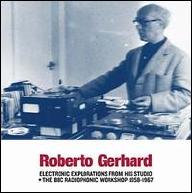In Vienna Gerhard found his way into the Schoenberg circle, of which he remained an active part (even moving to Berlin when Schoenberg was made a professor in that city) until his return to Barcelona in 1929. Gerhard was offered a position on the faculty of the Ecola Normal de la Generalitat in 1931, and from 1932 on was a member of the Advisory Council to the Catalan Minister of Fine Arts. Although performances of his music at ISCM festivals throughout the 1930s had begun to earn Gerhard a more international reputation as a composer, the outbreak of civil war in 1938 and subsequent defeat of the Republican forces (of which Gerhard was a supporter, having even served on the Central Music Council of the Spanish Republican Government in 1937) forced Gerhard to flee the country. He eventually found his way to Great Britain.
Gerhard remained virtually unknown to the musical public of his adopted country for the next fifteen years, and even the majority of British composers were unaware of his presence at Cambridge (where Gerhard had been offered a research scholarship by Cambridge historian and musicologist Edward Dent). By the mid-1950s, however, further ISCM performances and the premiere of his Symphony No.1 in Baden-Baden during 1955 had resulted in an increased awareness of Gerhard's merits as a composer, and from 1960 until his death in 1970 he served as visiting professor and composer-in-residence at universities and festivals around the globe (including the Tanglewood Music Center and the University of Michigan). He was made a Commander of the Order of the British Empire (C.B.E.) in 1967 and a Fellow of University College, Cambridge the following year.
Gerhard's earliest music, such as the Seven Haiku for voice and chamber group, on the strength of which he earned a place in Schoenberg's class, show a wide range of influences. By the end of Gerhard's time with Schoenberg he had begun to assimilate certain serial ideas; pieces like the Wind Quintet of 1928, however, show Gerhard's reluctance to use strict twelve-tone serial techniques-instead there is a pattern of intervallic structures which operate partly on serial techniques but don't demand a full twelve- note organization-and it would not be until the 1950s that Gerhard fully synthesized his own very textural and atmospheric style with a more rigorous twelve-tone underpinning. After his emigration to Great Britain in 1939 Gerhard made most of his income composing scores for various television, film, theater and radio productions; the composer's lighter side can be seen in a group of arrangements he made (under a pseudonym) of Spanish popular tunes in 1943. ~ Blair Johnston, Rovi


















